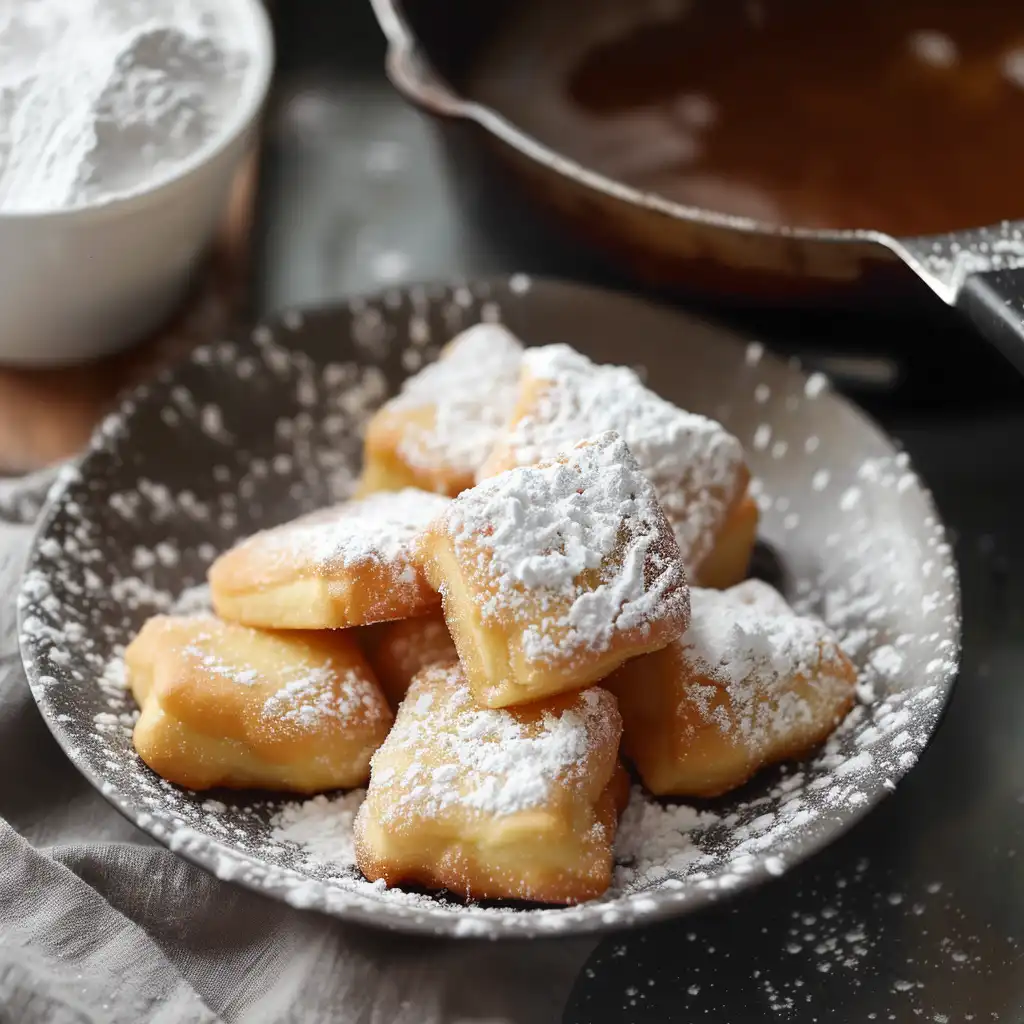These delicate Vanilla French Beignets are pillowy squares of fried dough dusted generously with powdered sugar, creating a truly authentic French pastry experience. Originating from the French Quarter of New Orleans but with roots in French culinary tradition, these beignets are infused with rich vanilla flavor that transforms this classic treat into something extraordinarily special. The combination of a light, airy interior and slightly crisp exterior makes these beignets irresistible to anyone who tries them.
Why You’ll Love This Recipe
- Authentic French pastry experience with a vanilla twist that elevates the traditional recipe
- Perfect balance of pillowy soft interior and slightly crisp exterior texture
- Impressively elegant dessert that’s actually approachable for home bakers
- Versatile as a breakfast treat, afternoon snack, or elegant dessert
- Makes your kitchen smell like a Parisian patisserie as they cook
Ingredients
- All-purpose flour: Forms the base of our beignet dough, providing structure and that classic texture. For a lighter result, you can substitute up to half with cake flour.
- Granulated sugar: Adds just the right sweetness to the dough while helping to feed the yeast. Brown sugar can be substituted for a slight caramel undertone.
- Active dry yeast: The leavening agent that creates those airy pockets inside. Instant yeast can be used as a substitute with slightly reduced rising time.
- Salt: Enhances all the flavors in the beignet and balances the sweetness. Kosher salt or fine sea salt works perfectly.
- Warm milk: Provides moisture and richness to the dough while activating the yeast. For a richer version, whole milk is recommended, but 2% will also work.
- Unsalted butter: Adds richness and a tender texture to the dough. Make sure it’s fully melted but not hot.
- Pure vanilla extract: The star flavor component that makes these beignets special. Use the highest quality you can find for the best flavor.
- Vegetable oil: For frying the beignets to golden perfection. Canola or peanut oil are excellent alternatives with high smoke points.
- Powdered sugar: For that classic generous dusting that makes beignets instantly recognizable. This is non-negotiable!
Variations
Chocolate-Filled Beignets
Transform these vanilla beignets into a chocolate lover’s dream by placing a small piece of high-quality chocolate in the center of each dough square before frying. As the beignets cook, the chocolate melts into a luscious molten center. Use dark, milk, or white chocolate depending on your preference.
Citrus Vanilla Beignets
Add a bright, zesty dimension to your beignets by incorporating 1 tablespoon of fresh orange or lemon zest into the dough alongside the vanilla extract. This creates a beautiful aromatic quality that complements the vanilla perfectly. Finish with a citrus-infused powdered sugar by mixing a little zest with your confectioners’ sugar.
Spiced Vanilla Beignets
For a warming twist, especially perfect for fall and winter, add 1 teaspoon of cinnamon and a pinch each of nutmeg and cardamom to the dry ingredients. These spices complement the vanilla and create a more complex flavor profile reminiscent of French pastries served during holiday seasons.
Coconut Vanilla Beignets
Replace half of the milk with coconut milk and add 1/4 teaspoon of coconut extract alongside the vanilla for a tropical variation. After frying, dust with a mixture of powdered sugar and toasted coconut flakes for added texture and flavor.
How to Make the Recipe
Step 1: Prepare the Dough
Begin by whisking together the flour, sugar, yeast, and salt in a large mixing bowl to ensure even distribution of ingredients. In a separate bowl, combine the warm milk (110°F), melted butter, and vanilla extract, stirring gently. Gradually add the wet ingredients to the dry mixture, stirring with a wooden spoon until a shaggy dough forms. Transfer to a lightly floured surface and knead for 8-10 minutes until smooth and elastic, adding small amounts of flour only if the dough is too sticky to handle.
Step 2: First Rise
Place the kneaded dough in a lightly oiled bowl, turning once to coat all sides. Cover the bowl with a clean kitchen towel or plastic wrap and set in a warm, draft-free location. Allow the dough to rise until doubled in size, which will take approximately 1.5 hours. You’ll know it’s ready when the dough springs back slowly when gently pressed with a finger.
Step 3: Shape the Beignets
Once doubled, gently punch down the dough to release air bubbles. Transfer to a lightly floured surface and roll out to approximately 1/4-inch thickness, maintaining an even pressure for uniform beignets. Using a sharp knife or pizza cutter, cut the dough into 2×2 inch squares. There’s no need to reroll scraps—oddly shaped beignets have their own rustic charm!
Step 4: Fry to Golden Perfection
Heat oil in a deep fryer or heavy-bottomed pot to exactly 360°F, using a thermometer for accuracy. Fry the beignets in small batches (4-5 at a time) to maintain oil temperature, turning them with a slotted spoon after about 1-2 minutes per side. They should puff dramatically and turn a beautiful golden brown. Transfer to paper towels to drain excess oil.
Step 5: Serve Immediately
While still warm, generously dust the beignets with powdered sugar using a fine-mesh sieve or powdered sugar shaker. The warmth of the freshly fried beignets will slightly melt the first layer of sugar, creating that characteristic sweet coating. Serve immediately for the most authentic experience, preferably with coffee or hot chocolate.
Tips for Making the Recipe
- Monitor your oil temperature carefully—too hot and the beignets will brown before cooking through, too cool and they’ll absorb oil and become greasy
- Use a thermometer when heating the milk to ensure it’s warm (110°F) but not hot, which would kill the yeast
- Let the dough rise in a warm spot—near (not on) a preheating oven works well in cooler kitchens
- Don’t overwork the dough when rolling and cutting, as this can make your beignets tough rather than tender
- Dust with powdered sugar while the beignets are still warm for the sugar to slightly adhere to the surface
- If making in humid weather, add an extra tablespoon of flour to counter the moisture in the air
How to Serve
Beignets are traditionally served piping hot, generously covered with powdered sugar, and accompanied by a strong cup of café au lait or chicory coffee. For an authentic New Orleans experience, serve on a small plate with powdered sugar scattered across the entire surface. They make a delightful breakfast treat, especially on weekend mornings, but are equally appropriate as an afternoon indulgence or dessert.
For a more elaborate presentation, consider serving with dipping sauces like chocolate ganache, caramel sauce, or raspberry coulis on the side. A small scoop of vanilla ice cream transforms these beignets into an elegant plated dessert for special occasions. Remember, beignets are meant to be enjoyed fresh—the experience of biting into a warm, freshly fried beignet is incomparable.
Make Ahead
While beignets are best enjoyed fresh, you can prepare components ahead of time to streamline the process. The dough can be made up to 24 hours in advance and stored in the refrigerator after the first rise. Simply punch down the dough, place in a covered container with room for expansion, and refrigerate. When ready to cook, allow the dough to come to room temperature for about 30 minutes before rolling, cutting, and frying.
For longer storage, the cut, unfried beignet squares can be frozen. Place them on a parchment-lined baking sheet, freeze until solid, then transfer to a freezer bag for up to one month. Thaw in the refrigerator overnight before frying. While not ideal, leftover fried beignets can be stored at room temperature in a paper bag for up to 24 hours and briefly reheated in a 350°F oven to restore some crispness.
FAQs
Why didn’t my beignets puff up when frying? (H3)
Beignets may not puff properly if the yeast was inactive or killed by too-hot liquid, or if the dough didn’t rise sufficiently. Ensure your yeast is fresh, your milk is warm (not hot), and you’ve allowed adequate rising time. Also check that your oil is at the correct temperature (360°F)—too cool and they won’t puff, too hot and they’ll brown before puffing.
Can I bake these beignets instead of frying them? (H3)
While traditional beignets are fried, you can bake them for a lighter version. Place the cut dough squares on a parchment-lined baking sheet, brush with melted butter, and bake at 400°F for about 10-12 minutes until golden. The texture will be more like a soft roll than a traditional beignet, but they’ll still be delicious with powdered sugar on top.
How can I ensure my beignets aren’t greasy? (H3)
To prevent greasy beignets, maintain the oil at a consistent 360°F throughout frying. Use a thermometer and allow the oil to return to temperature between batches. Don’t overcrowd the pan, which drops the oil temperature drastically. Finally, drain freshly fried beignets on paper towels immediately after removing from oil.
Can I make these without a stand mixer? (H3)
Absolutely! While a stand mixer makes the process easier, beignets have been made by hand for generations. Mix the ingredients with a wooden spoon until combined, then knead by hand on a floured surface. It will take slightly longer (about 10-12 minutes of kneading), but the results will be just as delicious.
Conclusion
These Vanilla French Beignets bring a taste of New Orleans and French tradition right to your kitchen with their pillowy texture and sweet vanilla flavor. The process of making them—from watching the dough rise to the dramatic puff as they hit the hot oil—is almost as rewarding as biting into these sugar-dusted delights. Whether served for a special breakfast, afternoon treat, or elegant dessert, these beignets create memorable moments around the table. Don’t be intimidated by the steps; the recipe is forgiving and the results are universally beloved. Treat yourself and your loved ones to this classic pastry experience—it’s a little bit of French Quarter magic in every bite.
Print
Vanilla French Beignets
- Total Time: 120 minutes (including rising time)
- Yield: 24 beignets 1x
- Diet: Vegetarian
Description
Fluffy, golden-brown beignets with a hint of vanilla, dusted generously with powdered sugar. These traditional French pastries are crispy on the outside and airy on the inside, perfect for a special breakfast or dessert treat.
Ingredients
- 2 ½ cups all-purpose flour
- ¼ cup granulated sugar
- 2 teaspoons active dry yeast
- ½ teaspoon salt
- 1 cup warm milk
- 1 tablespoon unsalted butter, melted
- 1 tablespoon pure vanilla extract
- Vegetable oil, for frying
- Powdered sugar, for dusting
Instructions
- Prepare Dry Ingredients
- In a large bowl, combine the 2 ½ cups of all-purpose flour, ¼ cup granulated sugar, 2 teaspoons active dry yeast, and ½ teaspoon salt. Mix well to distribute the yeast and sugar evenly through the flour.
- Mix Wet Ingredients
- In a separate bowl, whisk together 1 cup of warm milk (about 110°F), 1 tablespoon melted unsalted butter, and 1 tablespoon pure vanilla extract. Ensure the mixture is warm to touch, not hot, to activate the yeast without killing it.
- Combine Dry and Wet Ingredients
- Gradually pour the wet ingredients into the dry ingredients while stirring with a wooden spoon until a dough begins to form. Continue to mix until all ingredients are thoroughly combined.
- Knead the Dough
- Transfer the dough onto a lightly floured surface and knead for about 8-10 minutes until the dough is smooth and elastic. If the dough is too sticky, sprinkle a little more flour as needed.
- First Rise
- Place the kneaded dough into a greased bowl, turning it once to coat all sides with oil. Cover the bowl with a clean cloth and let it rise in a warm, draft-free area for about 1.5 hours, or until it has doubled in size.
- Shape the Beignets
- Once risen, punch down the dough and roll it out on a floured surface to about 1/4 inch thickness. Cut the dough into 2×2 inch squares using a sharp knife or pizza cutter.
- Heat the Oil
- Pour about 2 inches of vegetable oil into a deep fryer or large pot. Heat the oil to 360°F, using a candy or deep-fry thermometer to ensure accuracy.
- Fry the Beignets
- Fry the beignets in batches, careful not to overcrowd the pot, for about 1 to 2 minutes on each side, or until they are puffed up and golden brown. Use a slotted spoon to remove them from the oil and drain on paper towels.
- Serve
- Dust the freshly fried beignets with powdered sugar and serve immediately.
Notes
- Beignets are best enjoyed fresh and warm but can be stored in an airtight container for up to 2 days.
- The dough can be prepared the night before and refrigerated for the first rise overnight.
- Traditional New Orleans-style beignets use a slightly different recipe, often including eggs.
- Maintain oil temperature between 350-375°F for the crispiest results.
- For extra flavor, add 1/2 teaspoon of cinnamon to the flour mixture.
- Prep Time: 30 minutes
- Cook Time: 30 minutes
- Category: Desserts
- Method: Frying
- Cuisine: French
Nutrition
- Serving Size: 1 beignet
- Calories: 120
- Sugar: 5g
- Sodium: 50mg
- Fat: 5g
- Saturated Fat: 1g
- Unsaturated Fat: 4g
- Trans Fat: 0g
- Carbohydrates: 18g
- Fiber: 1g
- Protein: 2g
- Cholesterol: 5mg


